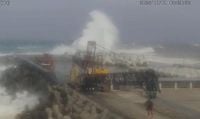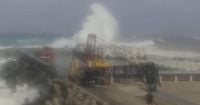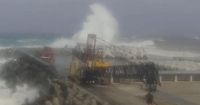Heavy rain from a powerful typhoon battered a chain of Japanese islands south of Tokyo on Thursday, October 9, 2025, prompting urgent warnings from the government and sending hundreds of residents to evacuation centers. The storm, which unleashed record rainfall across parts of the Izu island chain, has left communities on edge and claimed at least one life as authorities continue to monitor the situation for further threats of flooding and landslides.
According to Kyodo news agency, the Izu islands—located roughly 280 kilometers (174 miles) south of the Japanese capital—experienced rainfall levels that shattered previous records. The relentless downpour quickly overwhelmed local infrastructure, forcing officials to sound the alarm and urge residents to take immediate precautions. "We ask everyone to stay vigilant and heed evacuation orders," a government spokesperson said, emphasizing the risk of landslides and flash flooding in the hardest-hit areas.
The Izu island chain, known for its scenic beauty and volcanic origins, is no stranger to severe weather. But Thursday's storm was exceptional in its intensity and scale. As the typhoon's outer bands swept across the region, rainfall rates surged to levels not seen in years, inundating roads, swelling rivers, and threatening vulnerable slopes with collapse. The meteorological agency issued repeated advisories throughout the day, warning that the saturated ground could give way with little warning.
Hundreds of people responded to the call for caution, seeking shelter in evacuation centers set up by local authorities. These centers, equipped with basic supplies and staffed by emergency personnel, became temporary refuges for families and individuals anxious about the worsening conditions outside. "We brought some food and blankets and are just waiting for the rain to stop," one evacuee told Kyodo. "It was scary to see the water rising so quickly."
Tragically, the storm's ferocity proved fatal for at least one person. In Oiso, a coastal town in Kanagawa prefecture on Japan's main island of Honshu, a man lost his life after being swept away by powerful waves while fishing. Emergency responders rushed to the scene but were unable to save him. The incident underscored the dangers posed not only by the rain but also by the storm-driven surf and rapidly changing coastal conditions.
Japan's government moved swiftly to coordinate its disaster response, drawing on lessons learned from previous typhoons and floods. Local officials in the Izu islands and surrounding regions activated emergency protocols, deploying rescue teams and preparing for possible evacuations on a larger scale. The central government in Tokyo maintained close contact with local authorities, offering logistical and financial support as needed.
For residents of the Izu islands, Thursday's storm revived memories of past typhoons that have battered the region, sometimes with devastating consequences. The islands, stretching in a chain southward from the tip of the Izu Peninsula, are home to small communities that rely on tourism, fishing, and agriculture. Their geographic isolation can make disaster response especially challenging, as ferry services and flights are often suspended during severe weather.
Despite these obstacles, the community response was swift and organized. Emergency shelters were opened in schools and community centers, and volunteers helped distribute food, water, and blankets to those in need. Local media, including Kyodo news agency, provided frequent updates on the storm's progress and the evolving risk of landslides and flooding.
In Tokyo, the capital city remained largely unaffected by the direct impact of the typhoon, but officials kept a wary eye on the weather patterns. The memory of past disasters—such as Typhoon Hagibis in 2019, which caused widespread flooding and power outages—remained fresh in the minds of many. Authorities urged residents across the wider Kanto region to remain alert, as even distant storms can trigger dangerous conditions in Japan's mountainous terrain.
Japan's vulnerability to typhoons is well-documented. Each year, several powerful storms sweep up from the Pacific, bringing torrential rain, high winds, and the ever-present risk of landslides. The country's mountainous topography and densely populated coastal areas make it particularly susceptible to the effects of heavy rainfall. In recent years, climate scientists have warned that these storms may become more intense as global temperatures rise, increasing the need for robust disaster preparedness.
The events of October 9, 2025, provided a stark reminder of these risks. As the storm moved through the Izu islands, authorities prioritized the safety of residents above all else, urging people to avoid unnecessary travel and to stay away from rivers, cliffs, and other hazardous areas. The meteorological agency continued to monitor the situation closely, ready to issue further warnings if conditions deteriorated.
For those sheltering in evacuation centers, the uncertainty was palpable. "We don't know when we'll be able to go home," another evacuee told local reporters. "But we're grateful for the help and for having a safe place to stay." The sense of community solidarity was evident, with neighbors checking on each other and sharing resources as they waited out the storm.
In the aftermath of the typhoon, attention will turn to recovery and assessment. Authorities are expected to survey the extent of damage to infrastructure, homes, and farmland. Early reports suggested that the worst impacts were limited to localized flooding and minor landslides, but officials cautioned that the full picture would only emerge once the rain subsided and access to remote areas was restored.
The tragic death in Oiso served as a somber footnote to the day's events, highlighting the unpredictable and sometimes deadly nature of Japan's typhoon season. While most residents heeded warnings and stayed indoors, the lure of the sea proved fatal for one individual. "We urge everyone to respect the power of nature and to prioritize safety above all else," a government official said in a televised address.
As the storm system moved away from the Izu islands and weakened, meteorologists predicted a gradual return to calmer weather. However, the experience left a lasting impression on those affected—and reinforced the importance of preparedness in a country where nature's fury is never far away.
With the immediate crisis passing, residents and officials alike will reflect on the lessons learned and the resilience shown in the face of adversity. The story of the Izu islands' response to the typhoon is a testament to the strength of community and the value of timely, coordinated action in the face of natural disaster.


